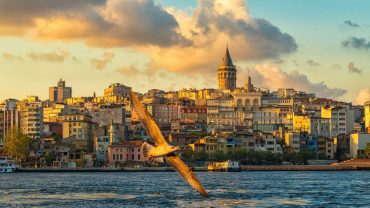Elazığ (Turkish: [eˈlazɯː]), formerly Mamuretülaziz, is a city in Eastern Anatolia, Turkey, and the administrative centre of Elazığ Province. It is located in the uppermost Euphrates valley. The plain on which the city extends has an altitude of 1,067 metres (3,501 ft). Elazığ resembles an inland peninsula surrounded by the natural Lake Hazar and reservoirs of Keban Dam, Karakaya Dam, Kıralkızı and Özlüce. The city has a Kurdish majority and was captured by Kurdish rebels during the Sheikh Said rebellion.
Etymology
In the 19th century, under the reign of Mahmud II, the governor Reşid Mehmed Pasha started an expansion of Mezre, a suburb located on the plain below Kharput. During the reign of Sultan Abdulaziz (r. 1861–1876), military barracks, a hospital and a governor’s mansion were built to accommodate the seat of a new vilayet (province). The town was renamed “Mamuretülaziz” (Ottoman Farsi: معمورة العزيز, lit. ‘made prosperous by Aziz’) in 1866 on the occasion of the fifth anniversary of the enthronement of Sultan Abdulaziz, although he was not the initial founder. In time the city became known as “Elâzîz” due to its ease of pronunciation. On November 17, 1937, President Mustafa Kemal Atatürk changed the name of the city to “El’azık”. However, since this was hard to pronounce in Turkish, on December 10, 1937, the government changed the city’s name to its final form, “Elazığ”.
History
The city of Elazığ was founded among the skirts of the hill on which the historical Harput Castle was constructed. According to the present historical sources, the most ancient inhabitants of Harput was the Hurrian nation who settled in these parts in c. 2000 B.C.
Harput and its surrounding region was part of the kingdom of Urartu at the period of its maximum extension.
The ancient town and citadel called Kharput (Kharpert), which means “rocky fortress” in Armenian, was built by the first Armenian kings about five km (3.1 miles) from modern Elazığ. However, very little written material about this city reached our day. It is possible that Harput stands on or is near the site of Carcathio-certa in Sophene, reached by Corbulo in A.D. 65. The early Muslim geographers knew it as Ḥiṣn Ziyād, but the Armenian name, Khartabirt or Kharbirt, whence Kharput and Harput, was generally adopted in time.
William of Tyre wrote that Joscelin I, Count of Edessa (Jocelyn) of Courtenay, and King Baldwin II of Jerusalem were prisoners of the Amir Balak in Kharput’s castle and that they were rescued by their Armenian allies. William of Tyre calls the place Quart Piert or Pierre.
Ottoman Harput and Mamûretü’l-Azîz
Harput and its vicinity fell under Turkish control in the year 1085 as the outcome of the battle of Manzikert on August 26, 1071. The Çubukoğulları, Artuqids, Sultanate of Rum, Ilkhanate, Beylik of Dulkadir, Aq Qoyunlu, Safavids and Ottomans had reigned in the region.
Harput was an important station of the American missionaries for many years. The missionaries built Euphrates College, a theological seminary, and boys’ and girls’ schools. It operated until 1915 when its buildings were confiscated and used by the Ottoman army as barracks. In November 1895, government-backed Turks and Kurds massacred, looted and burned the Armenian villages on the plain. In the same month, Harput was attacked and the American schools were burned down. During the Armenian Genocide, many residents were killed.
Harput is still partly settled today, but due to its high elevation and lack of water, it is slowly in the process of being abandoned, with most of its residents moving to Elazığ. Harput still has a few thousand inhabitants.
Turkish Republican era
Elazıg was the seat of the Fourth Inspectorate-General from 1936 until 1952. The Inspectorate General included the provinces of Elaziğ, Erzincan, Bingöl and Tunceli and it was governed by a Governor Commander under the military authority. He had wide-ranging power over the civilians and could order the capital punishment without the permission from the Turkish parliament. The office of the Governor Commander was eventually left vacant in 1948 but the legal framework for the Inspectorate-Generals was only abolished in 1952.
Economy
In the late 19th and early 20th century, Elazığ exported raisins, apricots and almonds to Europe. Opium was also grown in the area. Honey was also produced, but not so much exported, but used by locals. Gold was also found in the area in the early 20th century.
Many of those who were forced to move with the construction of the dam chose to settle in Elazığ centre and the state indemnities paid were invested in houses in Elazığ or laid a base for small businesses. However, the Keban Dam affected more than 30,000 people and at least 212 villages. Over 80% of families in zones affected by the Keban dam were landless peasants and thus ineligible to receive compensation or peasants with little land who would receive very little money (Koyunlu 1982: 250)
The dam, industry, and mining accounts for the high level of urbanization (42.7% in 1970) surpassing the average levels for Eastern Anatolia. The main agricultural activity of the area centers around vineyards and Elazığ also serves as a market hub for other agricultural products. The state-run vineyards of Elazığ are notable for its production of Buzbağ, a full-flavored red wine.
Today, Elazığ is the capital of the Elazığ province, a busy city with a university and an industrial base, although historic monuments are scarce. The exception is the ancient Harput citadel and town, a dependency of the greater municipality of Elazığ today situated three miles (4.8 km) to the north of the city centre. Elazığ is the most developed city (and province) in the region according to a report that was carried out by the Ministry of Development, making it the most developed region of Eastern Anatolia Region.
Geography
Elazığ is situated at the northwestern corner of a 30-mile-long valley, known locally as Uluova (literally the Great Valley). The area’s Armenians called this valley “Vosgetashd” (the Golden Plain). Its altitude is 3,300 feet (1,000 m), latitude and longitude of 38 degrees and 41 minutes North, and 39 degrees and 14 minutes East. Elazığ Province is surrounded by the Euphrates in the north, and since the completion of Keban Dam the rivers came to cover almost ten percent of the surface area (826 square kilometres (319 sq mi)) of the province (8,455 square kilometres (3,264 sq mi)). Elazığ’s adjacent province borders are with: Tunceli (North), Erzincan (North-West), Bingöl (East), Diyarbakır (South), and Malatya (West).
Cuisine
Elazığ cuisine is the second richest among all cities in Turkey with 154 different types of food and drinks according to a study conducted by Ankara Chamber of Commerce. Particularly those originated in the historic city of Harput have an important fame in the region and the country. Apart from famous meat platters most of which include meatballs, naturally dried fruits and vegetables and using them in main dishes are unique to Elazığ cuisine. Several examples could include:
Kofik dolma – stuffed dried peppers or aubergines
Kelecoş – fried meat and onion served over a bed of flatbread pieces softened in yogurt
İşkene – a breakfast soup containing broth and vegetables
Harput köfte – meatballs made with a mixture of minced meat, cracked wheat, herbs and spices boiled in tomato sauce
Taş Ekmeği – unleavened flatbread baked over hot stone or hotplate served with butter and jam
Işkın yemeği – a wild rhubarb dish
Sırın – pan-broiled handmade filo pastry roundels with a layer of yogurt and tomato sauce on top
Kömme – baked handmade filo pastry roundels built with a layer of meat filling and a layer of walnut paste
Gaygana – a mixture of eggs, yogurt, bicarbonate, and flour drops fried in oil
Orcik – walnut halves sewn in a thread, dipped into deep grape syrup
Orcik şekeri – caramelised sugar coated walnut pieces
Elazığ is also very famous with its vineyards, and two types of grape varieties Öküzgözü and Boğazkere.
Transportation
Elazığ is served by Elazığ Airport which lies about 12 km (7 mi) from the city center. The airport is the 19th busiest airport in Turkey in terms of passenger traffic. There are daily domestic flights from/to Ankara, Istanbul and İzmir. During summer months there are some international flights from/to cities such as Düsseldorf and Frankfurt as well as from/to Antalya and Adana.
There are local companies provide coach service to almost all cities in Turkey. Ferryboat services are also present over the reservoir lakes to supplement highway connections to towns such as Ağın, and Pertek and Çemişgezek of Tunceli.
The Blue Train (passenger express) provides connection from Elazığ to Ankara.
Education
Elazığ is home to Fırat University, established in 1975 and since has become one of the leading academic institutions in the eastern Turkey.
Education
Elazığ is home to Fırat University, established in 1975 and since has become one of the leading academic institutions in the eastern Turkey.






Comment (0)